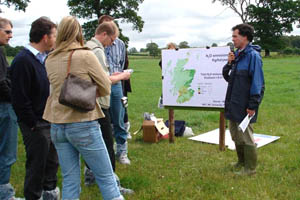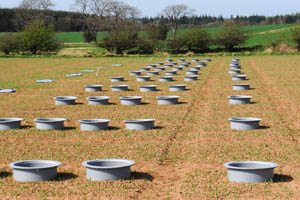Nitrous oxide - the forgotten greenhouse gas?
Published on 1 July 2011 in Climate, water and energy
SRUC (formerly SAC) has identified agricultural systems and management practices that minimise emissions of the powerful greenhouse gas nitrous oxide. This will help the government achieve its greenhouse gas reduction targets and can improve the efficiency and profitability of farm enterprises.

Key Challenges
The Scottish government’s climate change act requires an overall reduction of 80% in greenhouse gas emissions by 2050. It estimates that agriculture and related land use contributes around 20% of Scotland’s emissions and Nitrous oxide (N2O) forms a large proportion of the emissions coming from agriculture. N2O is produced as a result of the application of nitrogen fertilisers and the waste produced by livestock. One of the most effective ways of reducing these emissions is to improve the efficiency with which fertilisers and manures are used. The magnitude of emissions varies with location so advice needs to be tailored to farms’ specific circumstances. At a national level, a map showing baseline N2O emissions across the country is required, along with an understanding of how these change in response to climate and management.
Key Benefits
Research on greenhouse gas emissions from Scottish agriculture is helping to quantify emissions from the sector and to identify mitigation options that can help meet targets set by the Scottish Government’s Climate Change Bill.
SRUC’s research has shown that improving the way in which fertiliser nitrogen is managed can lead to significant reductions in greenhouse gas emissions. It has also demonstrated the importance of significant emissions from organic matter sources, particularly in wet conditions. The value of mitigation measures to the farming community has been demonstrated through the use of nitrification inhibitors. SRUC has also shown that following application of a nitrification inhibitor to grasslands in Dumfries, N2O emissions were reduced by up to 53%. This represented savings of about £40, which covers the cost of the inhibitor, but also annually saves 3.7 tonnes of CO2 equivalent per hectare.
“SRUC research has shown that reductions in agricultural emissions of nitrous oxide can be achieved in a way that generates both financial and environmental savings, while maintaining or increasing agricultural productivity.”
Understanding the effect of soil and farm management measures on N2O emissions has underpinned development of the Marginal Abatement Cost Curves that have been developed in collaboration with economists at SRUC. These have since been used within government to help establish carbon budgets in support of climate change legislation.


Comments or Questions
Related Websites
- Dr Bob Rees - Research Profile
- SRUC Carbon Management Centre
- SRUC Farming for a Better C...
- Defra GHG Platform
Our Partners
SRUC works with research partners across Scotland and internationally, including James Hutton Institute, CEH and a large number of EU partners. We are currently developing collaborative research with the Global Research Alliance.
Find Out More
For more information contact Bob Rees (Bob.Rees@sruc.ac.uk), SRUC Carbon Management Centre, Edinburgh EH9 3JG.Author
Bob Rees Bob.Rees@sruc.ac.uk





